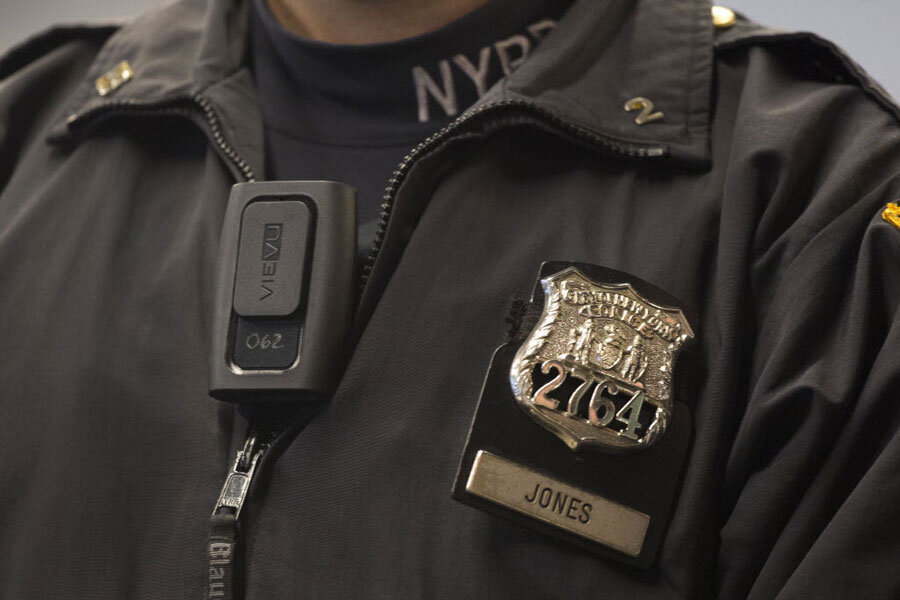Does Eric Garner chokehold case show limits of body cameras for police?
Loading...
| Los Angeles
Debate over the pros and cons of video in police work has flared in the wake of a grand jury’s decision Wednesday not to indict a Staten Island police officer in Eric Garner’s death, despite the existence of video of the incident that led to the unarmed man’s death this summer.
Video in the Garner case was taken by a civilian cell phone. But the lack of an indictment comes as communities from New York to Oakland, Calif., are moving aggressively to equip police officers with body cameras and the Obama administration is laying out $75 million to help speed the rollout.
But as the video tool gets a fast track nationally, many observers say the Garner case points out the limitations of the technology as a community policing tool, as well as the fact that the full range of pluses and minuses of this gear still need deeper consideration.
“Sometimes cameras give a false sense of security to both the police and community and this case really points that out,” says Tod Burke, professor of criminal justice at Radford University in Virginia and a former Maryland police officer.
Many complicating issues – such as timing of the clip, obstructions due to the angle of the shot, as well as unclear audio – are just a few reasons not to assume video will be a fix-all for community/police relations, says Professor Burke.
Beyond the technical ambiguities in the video itself, there are policy issues to be considered, he notes. Important questions, such as whether police are allowed to turn off the cameras, how long the footage will be stored, and who has access to it, are in the process of being hashed out.
“We should not just be rushing to put body cameras on police officers without addressing the many policy issues that the cameras raise,” he says.
The question of access is one that has come up in cities across the US.
In California, for example, the Voice of San Diego, a nonprofit investigative news organization, filed a request earlier this year for the footage of two San Diego police shootings. The department declined to turn over the footage, citing ongoing investigations. This week, a New Mexico police officer who failed to turn on his lapel camera before a fatal shooting this spring was fired by the Albuquerque Police Department, Reuters reported.
And on Nov. 20, the nonprofit Reporters Committee for Freedom of the Press appealed a denial by the Washington, D.C., police department for footage from the first two days officers began wearing body cameras as part of a six-month pilot program that had been touted as improving transparency. If the media and citizens can’t access the footage, critics point out, it’s unclear how such programs will meet that goal.
Burke points out that the presence of cameras in police work raise as-yet unanswered questions about everything from privacy rights to possible Fourth Amendment questions as well as how to handle interactions with minors and innocent bystanders whose images are unintentionally captured by the camera.
“We have to be able to answer some of these questions first,” says Burke, who notes that, despite these concerns, he believes the advantages of transparency in police work may ultimately outweigh disadvantages for both sides, an attitude supported by other legal observers as well as some early studies of the cameras’ use by police departments.
For example, after the police department in Rialto, Calif., added body cameras in February 2012, police use of force decreased by 60 percent and complaints against police officers dropped by 88 percent.
“If police officers wear body cameras it will debunk false charges and substantiate misconduct,” says New York criminal defense attorney Barry Slotnick, via e-mail.
Not everyone agrees with this assessment, however.
“Video cameras are a useful tool, but they are not the answer,” says criminal defense and civil rights attorney Norm Pattis, in an e-mail, adding, “as the Eric Garner case demonstrates. The tape shows us what happened, but the debate about whether the force was justified remains.”
And for some activists, technology is hardly the most paramount concern arising from the Garner case.
“This debate should not be about video cameras,” says New York community activist Leslie Haskins, an author and founder of Life Stations, a civil rights nonprofit devoted to finding solutions to issues surrounding race relations. “It should be about the underlying causes of what is happening in our cities and what we are going to do about it,” she adds.
Focus on short-term mechanical solutions will let both sides off the hook, says Ms. Haskins.
“You can put all the video cameras you want,” she says, “the fight is still the fight. We want to stop the need for the cameras.”
Haskins and other activists say it is more critical to seize the momentum of this moment to turn the tide toward more meaningful solutions to a stubborn historical problem.
“In five or ten years when we are teaching our children about Trayvon Martin and Eric Garner and Michael Brown, we need to be able to call this the defining moment when things began to change,” she says.
Her solutions include using the Obama seed money for community sensitivity training – “for both police and residents,” jobs and rebuilding blighted urban centers with basics such as recreational and community centers.
“This is what we need, not video cameras,” she adds.





